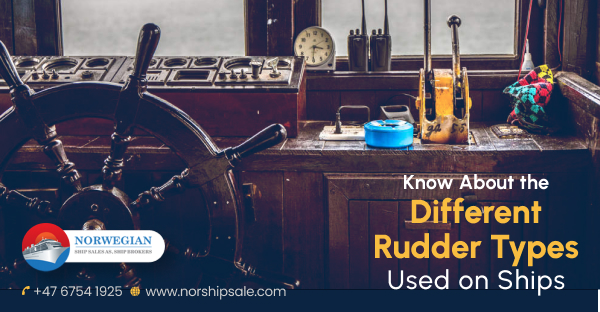Rudders are well-known and most important parts of ships, boats, and aircraft that help them to steer and maneuver. Rudders used on a ship are not like the ones that are used on an aircraft. Further, the rudders that are used on the ships also may differ from one another. This is because the type of rudder that would be the best fit for a particular ship is decided based on different factors. These include the propeller design of the ship, the hull design, the stern’s structural arrangement, the space between the stern and the propeller and more. Before, you or anyone else who buys any types of ferries for sale should have a fair idea about the types of rudders that are used on the ship. So, to learn about the different types of rudders used in ships, you can check out this blog.

Balanced or Spade Rudder
A spade or balanced rudder is a rudder plate that is attached to a rudder stock at its top. This rudder has around 20-40 per cent area forward of the stock. Also, the torque is not there on the rudder stock in this type of rudder. The rudder stock, which serves as the rudder’s axis does not run down the entire length of the rudder, it is placed at or near the centre of gravity. Therefore, the torque is less required to move the rudder.
Unbalanced Rudders
Unbalanced rudders are the ones whose stocks are situated at the span’s forwardmost point. In these types, the rudder stock runs along the rudder’s chord length, unlike in the balanced rudders. This is because the torque required is much higher than in the balanced rudders to move the rudder. Therefore, it is necessary to fix the rudder’s topmost part to the spindle to prevent any vertical displacement from its original position. These unbalanced rudders are not much used nowadays.
Semi-Balanced Rudder
The semi-balanced rudder was developed to find a solution to problems that were faced by using balanced and unbalanced rudders during steering gear system failure. The balanced and unbalanced rudder with their angle of attack would stay still while turning the ship. In a semi-balanced rudder, the top portion of the chord length is unbalanced while the remaining part of the chord length is balanced. This is because while the unbalanced part will extend the right structural support, the balanced part will allow the minimum torque to move the rudder. Thus, the semi-balanced rudder returns to the centreline automatically when the steering gear system fails when the ship changes direction. Nowadays, ships are mostly equipped with this type of rudder.
Pleuger Rudder
This is one of the most advanced rudder mechanisms. Pledger rudder helps huge ships that cannot use their propeller while turning, to maneuver easily. This type of rudder has a small-size auxiliary propeller placed in it, now when this is mounted on the rudder, a thrust is generated in the direction the rudder is oriented. Therefore, at slow speed also, the massive ship can man oeuvre properly.
Flaps Rudder
This rudder works with a similar principle used in the aeroplane’s wings. Here, flaps attached to the wings help to change the proper angle of attack of the wing’s aerofoil section. These wings are deployed while taking off to attain the right angle of attack and achieve the maximum force to lift the Aeroplan. However, the rudders are not retractable and have significant effects.
Voith Propulsion
Voith propulsion is a commendable invention as it is a propulsion system that also functions as a rudder. Without any rudder control surface, this can change the direction of the ship. This rudder consists of multiple hydrofoil blades that are placed on a disc, which is again placed on a hull. As this disc rotates on a horizontal plane around a horizontal axis it extends a rotation into its blades. Now, these blades can be adjusted to have a varying angle of attack during the propeller’s operation, depending on this magnitude and direction are varied.
To buy a top-notch ferry for sale, you can contact a reliable shipbroker.
Conclusion
So, this is what you need to know about various types of rudders that are used on ships. Now, since you already have an idea that the more advanced the rudder used on the ship, the more easily the ship man oeuvres. Therefore, before buying a ferry for sale, do check the rudder used on the ship. For a better understanding and buying a good ship consult an experienced shipbroker.

